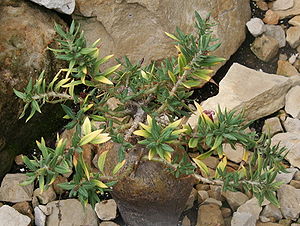- Pachypodium bispinosum
-
Pachypodium bispinosum 
Pachypodium bispinosum
Systematik Euasteriden I Ordnung: Enzianartige (Gentianales) Familie: Hundsgiftgewächse (Apocynaceae) Unterfamilie: Apocynoideae Gattung: Pachypodium Art: Pachypodium bispinosum Wissenschaftlicher Name Pachypodium bispinosum (L.f.) A.DC Pachypodium bispinosum ist eine Pflanzenart aus der Gattung Pachypodium in der Familie der Hundsgiftgewächse (Apocynaceae).
Inhaltsverzeichnis
Beschreibung
Pachypodium bispinosum ist eine ausdauernde Pflanze, mit einem dicken, fleischigen, frei verzweigten Stamm, der mit paarweise stehenden, bis zu 2 cm langen Dornen besetzt ist. Die Ränder der Laubblätter sind nach unten eingerollt.
Die Blüten besitzen eine breit glockenförmige Röhre mit einer Länge von 1,5 bis 2 cm und einem Durchmesser von 4 bis 8 mm. Die Kronröhre ist innen und außen rot gefärbt und ist mit breiten, zurückgebogenen, weiß gefärbten Kronlappen besetzt, die gerundet und 7 mm lang sind.
Die Samen sind 4 bis 5 mm lang und dunkel braun.
Systematik
Die Art steht nahe der Art Pachypodium succulentum. Die Verbreitungsgebiete der beiden Arten überlappen sich, selten wurden auch Hybride zwischen beiden Arten gefunden, die zwar überlebensfähig, aber steril sind.
Vorkommen
Die Art ist in der Ostkapregion Südafrikas verbreitet und wächst in Höhen bis 600 m.
Literatur
- G.D. Rowley: Pachipodium. In: Urs Eggli (Hrsg.): Illustrated Handbook of Succulent Plants: Dicotyledons. Springer Verlag, 2002, ISBN 978-3-540-41966-2, S. 12-13.
Weblinks
 Commons: Pachypodium bispinosum – Album mit Bildern und/oder Videos und Audiodateien
Commons: Pachypodium bispinosum – Album mit Bildern und/oder Videos und Audiodateien
Wikimedia Foundation.
